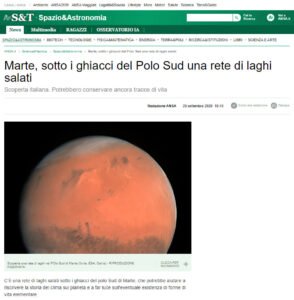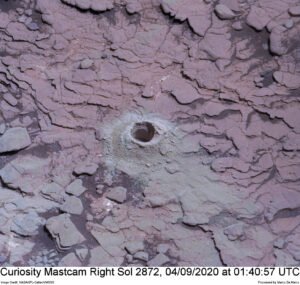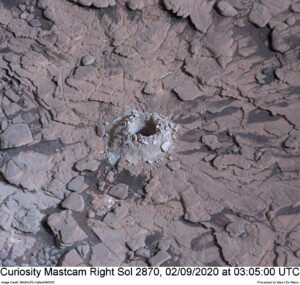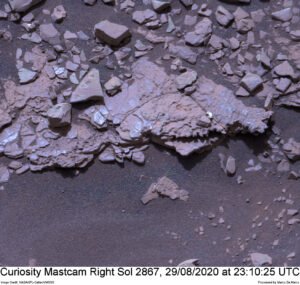Latest Posts
Mars evening: searching for life on the Red Planet with Marco De Marco and Giorgio Bianciardi
Evening dedicated to Mars organized by the Observatory N. Copernicus of Saludecio (RM), on October 10, 2020.The astrophile Marco De Marco illustrates the Martian climate from different points of view, while the astrobiologist Giorgio Bianciardi illustrates all the research done to find life on Mars and its shocking results.Astronomical Observatory N. Copernicus: https://www.facebook.com/groups/infocopernico Planet Mars – by Marco De Marco: https://www.facebook.com/PianetaMarte.MdM https://ilpianetamarte.org/ Prof. Giorgio Bianciardi: https://it.wikipedia.org/wiki/Giorgio_Bianciardi This post has been automatically translated. See the original post here.
Post from October 07, 2020
Be sure to attend in large numbers!!! 😉 This post has been automatically translated. See the original post here.
Mars, under the ice of the South Pole a network of salt lakes
As announced by Prof. Roberto Orosei during the live on July 30 on this page (see https://youtu.be/wQPjWA0tL0Y?t=8998), there is a network of salt lakes under the ice of the South Pole of Mars!Around the lake discovered in 2018 by an Italian group, there are three others, described in the journal Nature Astronomy by the same authors of the first study, coordinated by Elena Pettinelli and Sebastian Emanuel Lauro, from the University of Roma Tre, with Roberto Orosei, from the National Institute of Astrophysics (INAF). Researchers from the National Research Council (CNR) and Italians working in Australia (University of Southern Queensland) and Germany (Jacobs University in Bremen) participated. The new lakes were also discovered with the Marsis radar, provided by the Italian Space Agency (Asi) to the Mars Express mission of the European Space Agency (ESA). “Compared to 2018, we have greatly expanded the study area and used a different method of analysis, now the data indicate that there is a larger water system,” Elena Pettinelli told ANSA. If two years ago the research had been conducted on an area of 20 square kilometers, now an area of 250 kilometers by 300 has been reviewed and “the fact that there are complex hydrological structures suggests that there may be more.” ANSA article: https://www.ansa.it/canale_scienza_tecnica/notizie/spazio_astronomia/2020/09/28/marte-sotto-i-ghiacci-del-polo-sud-una-rete-di-laghi-salati-_430b66c9-c16a-4076-acc3-6801977c7fd2.html Nature Astronomy article: https://www.nature.com/articles/s41550-020-1200-6 Full Live of July 30 “Perseverance, the search for life on Mars restarts!”: https://www.facebook.com/1612043482212172/videos/579172016090917 This post has been automatically translated. See the original post here.
Q&A su Marte con Roberto Orosei
2020 has been defined by many as the year of Mars, there are many space missions dedicated to this planet in the launch phase or close to realization. Together with Roberto Orosei of INAF Bologna we will take stock of what we know about the red planet and what we hope to discover in the coming years. Elisa Nichelli will lead the meeting. https://www.youtube.com/watch?v=Aka0L4ODpQ4 This post has been automatically translated. See the original post here.
Curiosity Sol 2887, September 19, 2020
At 11:56:24 UTC the Mastcam Right re-imaged the excavation named “Mary Anning 3” (see https://www.facebook.com/PianetaMarte.MdM/posts/3232966906786480 and https://www.facebook.com/PianetaMarte.MdM/posts/3241879602561877). By comparing with the previous images, we have confirmation that the excavated material has undergone the same changes observed in the previous excavation (see https://www.facebook.com/PianetaMarte.MdM/posts/3176207112462460). It would seem that this second excavation in the Mary Anning area served to confirm the detection of particular organic compounds, not yet specified.I will await with great curiosity the first publication on this subject.The original image is a black and white encoding of the Bayer mask that has been converted to color through a process called “debayering” or “demosaicing”. In addition, the photo has undergone noise reduction due to Jpeg compression, white balance and a slight increase in microcontrast and color saturation in order to make the colors more similar to what the human eye would see. Original image: https://mars.nasa.gov/msl-raw-images/msss/02887/mcam/2887MR0150630001300016C00_DXXX.jpg This post has been automatically translated. See the original post here.
Curiosity Sol 2872, September 4, 2020
At 01:40:57 UTC the Mastcam Right re-shot the excavation named “Mary Anning 3” (see https://www.facebook.com/PianetaMarte.MdM/posts/3232966906786480). A comparison with the previous image, taken only two days earlier, shows the same changes observed in the previous excavation (see https://www.facebook.com/PianetaMarte.MdM/posts/3139037619512743). The extreme similarity between the two excavations, however, performed in the same area (Mary Anning), makes me suspect that during the first analysis of the previous excavation has emerged something particularly interesting to require a second excavation to confirm the possible discovery.I repeat that this is only my suspicion and that in any case could pass some months before a possible confirmation.The original image is a black and white encoding of the Bayer mask that has been converted to color through a process called “debayering” or “demosaicing”. In addition, the photo has undergone noise reduction due to Jpeg compression, white balance and a slight increase in microcontrast and color saturation in order to make the colors more similar to what the human eye would see. Original image: https://mars.nasa.gov/msl-raw-images/msss/02872/mcam/2872MR0149840000305688C00_DXXX.jpg This post has been automatically translated. See the original post here.
Curiosity Sol 2870, September 2, 2020
At 03:05:00 UTC the Mastcam Right filmed the new excavation in the rock performed by the Curiosity driller.This drilling, called “Mary Anning 3”, is 1.6 cm wide and shows us the true color of the rock apart from the reddish layer that covers it.Also in this case, as for the previous excavation (see https://www.facebook.com/PianetaMarte.MdM/posts/3134289306654241), the excavated material appears of a very faded pink, although the inner part of the excavation shows some tenuous turns to blue. It will be very interesting to see if its evolution over time will follow that of the previous excavation with its almost identical appearance!The original image has undergone noise reduction due to Jpeg compression, white balance and a slight increase in microcontrast and color saturation in order to make the colors more similar to what the human eye would see. Original image: https://mars.nasa.gov/msl-raw-images/msss/02870/mcam/2870MR0149740010405611E01_DXXX.jpg This post has been automatically translated. See the original post here.
Curiosity Sol 2867, August 29, 2020
At 23:10:25 UTC Mastcam Right imaged this gorgeous layered rock, with clear or perhaps reflective layers.Limestone veins are visibly present in this rock, but some very clear areas look particularly reflective rather than limestone rich. The only confirmation will come either with more photos or direct analysis.Let’s wait and see which of the two hypotheses will eventually be confirmed.The original image is a black and white encoding of the Bayer mask that has been converted to color through a process called “debayering” or “demosaicing”. In addition, the photo has undergone a reduction of noise due to Jpeg compression, white balance and a slight increase in microcontrast and color saturation in order to make the colors more similar to what the human eye would see. Original image: https://mars.nasa.gov/msl-raw-images/msss/02867/mcam/2867MR0149570000505548C00_DXXX.jpg This post has been automatically translated. See the original post here.
Analysis of NASA lander’s seismograph data reveals boundaries from crust to core
Using data from NASA’s InSight lander, seismologists at Rice University on Mars have made the first direct measurements of the three subsurface boundaries, from the crust to the core of the red planet. “Ultimately, it could help us understand planetary formation,” said Alan Levander, co-author of a study available online this week in Geophysical Research Letters. While the thickness of Mars’ crust and the depth of its core have been calculated using a variety of models, Levander said the InSight data allowed the first direct measurements, which can be used to check the models and ultimately improve them. “In the absence of plate tectonics on Mars, its early history is mostly preserved compared to Earth,” said study co-author Sizhuang Deng, a graduate student at Rice University. “Depth estimates of Martian seismic boundaries may provide insights to better understand its past as well as the formation and evolution of terrestrial planets in general.” Finding clues about Mars’ interior and the processes that formed it are key goals for InSight, the lander that landed in November 2018. The probe’s domed seismometer allows scientists to listen for faint rumblings inside the planet, in a way very similar to a doctor listening to a patient’s heartbeat with a stethoscope. Seismometers measure the vibrations of seismic waves. Like the circular ripples that mark the point where a pebble has disturbed the surface of a pond, seismic waves flow through planets, marking the location and size of disturbances such as meteor impacts or earthquakes, which are aptly named martemots on the red planet. InSight’s seismometer recorded more than 170 such events from February through September 2019. Seismic waves are also slightly altered as they pass through different types of rock. Seismologists have studied patterns in seismographic recordings on Earth for more than a century and can use them to map the location of oil and gas deposits and much deeper layers. “The traditional way to investigate structures beneath Earth is to analyze earthquake signals using dense networks of seismic stations,” Deng said. “Mars is much less tectonically active, which means it will have far fewer seismic events than Earth. Also, with only one seismic station on Mars, we cannot use methods that normally rely on seismic survey networks.” Levander and Deng analyzed InSight’s 2019 seismological data using a technique called ambient noise autocorrelation. “It uses continuous noise data recorded by the single seismic station on Mars to extract reflection signals from seismic boundaries,” Deng said. The first boundary measured by Deng and Levander is the division between Mars’ crust and mantle nearly 35 kilometers below the lander. The second is a transition zone within the mantle where magnesium and iron silicates undergo a geochemical change. Above the zone the elements form a mineral called olivine and below it heat and pressure compress them into a new mineral called wadsleyite. Known as the olivine-wadsleyite transition, this zone was found 1,110-1,170 kilometers below InSight. “The temperature at the olivine-wadsleyite transition is an important key to building thermal models of Mars,” Deng said. “From the depth of the transition, we can easily calculate the pressure, and with that, we can derive the temperature.” The third boundary he and Levander measured is the boundary between Mars’ mantle and its iron-rich core, which they found about 1,520 to 1,600 kilometers below the lander. A better understanding of this boundary “may provide information about the planet’s development from both chemical and thermal perspectives,” Deng said. Free translation of article, “Rice researchers use InSight for deep Mars measurements” http://news.rice.edu/2020/08/05/rice-researchers-use-insight-for-deep-mars-measurements-2/ Other reference article:“NASA InSight gives us the first real peek at Mars’ interior structure” https://www.theweathernetwork.com/ca/news/article/nasa-insight-gives-us-first-real-peek-at-the-interior-structure-of-mars This post has been automatically translated. See the original post here.
Curiosity Sol 2852, August 14, 2020
At 13:38:08 UTC the Mastcam Right re-shot the excavation called “Mary Anning” (see https://www.facebook.com/PianetaMarte.MdM/posts/3150638091686029 , https://www.facebook.com/PianetaMarte.MdM/posts/3139037619512743 and https://www.facebook.com/PianetaMarte.MdM/posts/3134289306654241). From the comparison with the previous image, taken nine days earlier, no particular chromatic differences can be seen. On the other hand, it can be seen that most of the excavated material has been dispersed by the wind, mainly towards the lower right corner of the image, probably the prevailing wind direction in that area.Personally, this is the first time I’ve seen the wind sweep away all the excavated material in this way, material that usually compacts and remains around the excavation.The original image is a black and white encoding of the Bayer mask that has been converted to color through a process called “debayering” or “demosaicing”. In addition, the photo has undergone noise reduction due to Jpeg compression, white balance and a slight increase in microcontrast and color saturation in order to make the colors more similar to what the human eye would see. Original image: https://mars.nasa.gov/msl-raw-images/msss/02852/mcam/2852MR0149060000505245C00_DXXX.jpg This post has been automatically translated. See the original post here.






